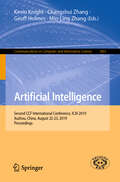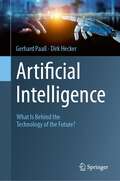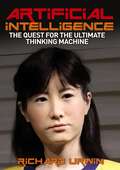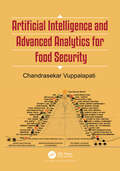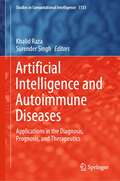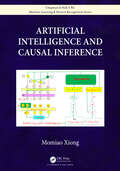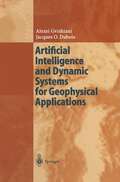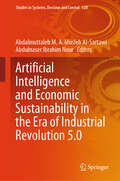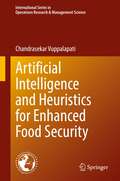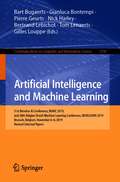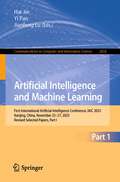- Table View
- List View
Artificial Intelligence: Second CCF International Conference, ICAI 2019, Xuzhou, China, August 22-23, 2019, Proceedings (Communications in Computer and Information Science #1001)
by Kevin Knight Changshui Zhang Geoff Holmes Min-Ling ZhangThis book constitutes the refereed proceedings of the Second CCF International Conference on Artificial Intelligence, CCF-ICAI 2019, held in Xuzhou, China in August, 2019. The 23 papers presented were carefully reviewed and selected from 97 submissions. The papers are organized in topical sections on deep learning, image and video processing, NLP and recommender system, machine learning algorithms, and AI applications.
Artificial Intelligence: 16th Russian Conference, RCAI 2018, Moscow, Russia, September 24-27, 2018, Proceedings (Communications in Computer and Information Science #934)
by Sergei O. Kuznetsov Gennady S. Osipov Vadim L. StefanukThis book constitutes the proceedings of the 16th Russian Conference on Artificial Intelligence, RCAI 2018, Moscow, Russia, in September 2018. The 22 full papers presented along with 4 short papers in this volume were carefully reviewed and selected from 75 submissions. The conference deals with a wide range of topics, including data mining and knowledge discovery, text mining, reasoning, decision making, natural language processing, vision, intelligent robotics, multi-agent systems, machine learning, ontology engineering.
Artificial Intelligence: 17th Russian Conference, RCAI 2019, Ulyanovsk, Russia, October 21–25, 2019, Proceedings (Communications in Computer and Information Science #1093)
by Sergei O. Kuznetsov Aleksandr I. PanovThis book constitutes the proceedings of the 17th Russian Conference on Artificial Intelligence, RCAI 2019, held in Ulyanovsk, Russia, in October 2019. The 23 full papers presented along with 7 short papers in this volume were carefully reviewed and selected from 130 submissions. The conference deals with a wide range of topics, including multi-agent systems, intelligent robots and behaviour planning; automated reasoning and data mining; natural language processing and understanding of texts; fuzzy models and soft computing; intelligent systems and applications.
Artificial Intelligence: What Is Behind the Technology of the Future?
by Gerhard Paaß Dirk HeckerArtificial Intelligence (AI) is already present in our daily routines, and in the future, we will encounter it in almost every aspect of life – from analyzing X-rays for medical diagnosis, driving autonomous cars, maintaining complex machinery, to drafting essays on environmental problems and drawing imaginative pictures. The potentials of AI are enormous, while at the same time many myths, uncertainties and challenges circulate that need to be tackled. The English translation of the book “Künstliche Intelligenz – Was steckt hinter der Technologie der Zukunft?” originally published in German (Springer Vieweg, 2020), this book is addressed to the general public, from interested citizens to corporate executives who want to develop a better and deeper understanding of AI technologies and assess their consequences. Mathematical basics, terminology, and methods are explained in understandable language. Adaptations to different media such as images, text, and speech and the corresponding generative models are introduced. A concluding discussion of opportunities and challenges helps readers evaluate new developments, demystify them, and assess their relevance for the future.
Artificial Intelligence: The Quest for the Ultimate Thinking Machine
by Richard UrwinWhat is Artificial Intelligence (AI)? What can it do and how is it created? In this highly accessible guide to the subject, Richard Urwin bases his assessment of AI on the definition of AI as a tool that is 'constructed to aid or substitute for human thought'. He explains how AI came about, the importance of the development of the computer and then examines how AI has developed over the years through the construction of computer programs and how the language used to construct these programs has become more and more sophisticated, thus allowing AI to become better and better. Along the way, you will discover numerous intriguing examples of how scientists have progressed the development of AI, learn about Fuzzy Logic and the ups and downs of computer programming, as well as finding out how research into brain function is continually influencing the field of AI. By turns fascinating and scary, Artificial Intelligence will take the reader on an amazing journey that covers everything from the habits of ants to the world of the stock market.
Artificial Intelligence and Advanced Analytics for Food Security
by Chandrasekar VuppalapatiClimate change, increasing population, food-versus-fuel economics, pandemics, etc. pose a threat to food security to unprecedented levels. It has fallen upon the practitioners of agriculture and technologists of the world to innovate and become more productive to address the multi-pronged food security challenges. Agricultural innovation is key to managing food security concerns. The infusion of data science, artificial intelligence (AI), advanced analytics, satellites data, geospatial data, climatology, sensor technologies, and climate modeling with traditional agricultural practices such as soil engineering, fertilizers use, and agronomy are some of the best ways to achieve this. Data science helps farmers to unravel patterns in fertilizer pricing, equipment usage, transportation and storage costs, yield per hectare, and weather trends to better plan and spend resources. AI enables farmers to learn from fellow farmers to apply best techniques that are transferred learning from AI to improve agricultural productivity and to achieve financial sustainability. Sensor technologies play an important role in getting real-time farm field data and provide feedback loops to improve overall agricultural practices and can yield huge productivity gains. Advanced Analytics modeling is essential software technique that codifies farmers’ tacit knowledge such as better seed per soil, better feed for dairy cattle breed, or production practices to match weather pattern that was acquired over years of their hard work to share with worldwide farmers to improve overall production efficiencies, the best antidote to food security issue. In addition to the paradigm shift, economic sustainability of small farms is a major enabler of food security. The book reviews all these technological advances and proposes macroeconomic pricing models that data mines macroeconomic signals and the influence of global economic trends on small farm sustainability to provide actionable insights to farmers to avert any financial disasters due to recurrent economic crises.
Artificial Intelligence and Advanced Analytics for Food Security
by Chandrasekar VuppalapatiClimate change, increasing population, food-versus-fuel economics, pandemics, etc. pose a threat to food security to unprecedented levels. It has fallen upon the practitioners of agriculture and technologists of the world to innovate and become more productive to address the multi-pronged food security challenges. Agricultural innovation is key to managing food security concerns. The infusion of data science, artificial intelligence (AI), advanced analytics, satellites data, geospatial data, climatology, sensor technologies, and climate modeling with traditional agricultural practices such as soil engineering, fertilizers use, and agronomy are some of the best ways to achieve this. Data science helps farmers to unravel patterns in fertilizer pricing, equipment usage, transportation and storage costs, yield per hectare, and weather trends to better plan and spend resources. AI enables farmers to learn from fellow farmers to apply best techniques that are transferred learning from AI to improve agricultural productivity and to achieve financial sustainability. Sensor technologies play an important role in getting real-time farm field data and provide feedback loops to improve overall agricultural practices and can yield huge productivity gains. Advanced Analytics modeling is essential software technique that codifies farmers’ tacit knowledge such as better seed per soil, better feed for dairy cattle breed, or production practices to match weather pattern that was acquired over years of their hard work to share with worldwide farmers to improve overall production efficiencies, the best antidote to food security issue. In addition to the paradigm shift, economic sustainability of small farms is a major enabler of food security. The book reviews all these technological advances and proposes macroeconomic pricing models that data mines macroeconomic signals and the influence of global economic trends on small farm sustainability to provide actionable insights to farmers to avert any financial disasters due to recurrent economic crises.
Artificial Intelligence and Autoimmune Diseases: Applications in the Diagnosis, Prognosis, and Therapeutics (Studies in Computational Intelligence #1133)
by Khalid Raza Surender SinghThe book provides an overview of various autoimmune disorders and how artificial intelligence (AI) and machine learning will be used for the diagnosis, prognosis, and treatment of these disorders. AI algorithms are used to create synthetic patient populations with the properties of actual patient cohorts, build personalized predictive models of drug combinations and unravel complex relationships between diet, microbiome, and genetic line-up to determine the comparative treatment response. The book highlights clinical applications and challenges of AI for the diagnosis and treatment/management of autoimmune disorders which includes Rheumatoid Arthritis (RA), Multiple Sclerosis (MS), Type I Diabetes, Psoriatic Arthritis (PsA), and other critical diseases.
Artificial Intelligence and Causal Inference
by Momiao XiongArtificial Intelligence and Causal Inference address the recent development of relationships between artificial intelligence (AI) and causal inference. Despite significant progress in AI, a great challenge in AI development we are still facing is to understand mechanism underlying intelligence, including reasoning, planning and imagination. Understanding, transfer and generalization are major principles that give rise intelligence. One of a key component for understanding is causal inference. Causal inference includes intervention, domain shift learning, temporal structure and counterfactual thinking as major concepts to understand causation and reasoning. Unfortunately, these essential components of the causality are often overlooked by machine learning, which leads to some failure of the deep learning. AI and causal inference involve (1) using AI techniques as major tools for causal analysis and (2) applying the causal concepts and causal analysis methods to solving AI problems. The purpose of this book is to fill the gap between the AI and modern causal analysis for further facilitating the AI revolution. This book is ideal for graduate students and researchers in AI, data science, causal inference, statistics, genomics, bioinformatics and precision medicine. Key Features: Cover three types of neural networks, formulate deep learning as an optimal control problem and use Pontryagin’s Maximum Principle for network training. Deep learning for nonlinear mediation and instrumental variable causal analysis. Construction of causal networks is formulated as a continuous optimization problem. Transformer and attention are used to encode-decode graphics. RL is used to infer large causal networks. Use VAE, GAN, neural differential equations, recurrent neural network (RNN) and RL to estimate counterfactual outcomes. AI-based methods for estimation of individualized treatment effect in the presence of network interference.
Artificial Intelligence and Causal Inference
by Momiao XiongArtificial Intelligence and Causal Inference address the recent development of relationships between artificial intelligence (AI) and causal inference. Despite significant progress in AI, a great challenge in AI development we are still facing is to understand mechanism underlying intelligence, including reasoning, planning and imagination. Understanding, transfer and generalization are major principles that give rise intelligence. One of a key component for understanding is causal inference. Causal inference includes intervention, domain shift learning, temporal structure and counterfactual thinking as major concepts to understand causation and reasoning. Unfortunately, these essential components of the causality are often overlooked by machine learning, which leads to some failure of the deep learning. AI and causal inference involve (1) using AI techniques as major tools for causal analysis and (2) applying the causal concepts and causal analysis methods to solving AI problems. The purpose of this book is to fill the gap between the AI and modern causal analysis for further facilitating the AI revolution. This book is ideal for graduate students and researchers in AI, data science, causal inference, statistics, genomics, bioinformatics and precision medicine. Key Features: Cover three types of neural networks, formulate deep learning as an optimal control problem and use Pontryagin’s Maximum Principle for network training. Deep learning for nonlinear mediation and instrumental variable causal analysis. Construction of causal networks is formulated as a continuous optimization problem. Transformer and attention are used to encode-decode graphics. RL is used to infer large causal networks. Use VAE, GAN, neural differential equations, recurrent neural network (RNN) and RL to estimate counterfactual outcomes. AI-based methods for estimation of individualized treatment effect in the presence of network interference.
Artificial Intelligence and Dynamic Systems for Geophysical Applications
by Alexej Gvishiani Jacques O. DuboisThe book presents new clustering schemes, dynamical systems and pattern recognition algorithms in geophysical, geodynamical and natural hazard applications. The original mathematical technique is based on both classical and fuzzy sets models. Geophysical and natural hazard applications are mostly original. However, the artificial intelligence technique described in the book can be applied far beyond the limits of Earth science applications. The book is intended for research scientists, tutors, graduate students, scientists in geophysics and engineers
Artificial Intelligence and Economic Sustainability in the Era of Industrial Revolution 5.0 (Studies in Systems, Decision and Control #528)
by Abdalmuttaleb M. A. Musleh Al-Sartawi Abdulnaser Ibrahim NourIndustry 5.0 has been dubbed as the digital revolution with a soul. This book incorporates a wealth of research which integrates artificial intelligence (AI) with economic sustainability and Industry 5.0. It examines the human-centricity of the upcoming digital revolution and the role of sustainable technologies in enhancing the livelihoods of workers, individuals, communities, and eventually societies. It provides insight on important areas related to artificial intelligence, sustainable development, and society 5.0. The chapters present a wide range of topics including block cipher, entrepreneurship and AI, AI and stock trading decisions, digital transformation, knowledge management, chatbot engineering, cybersecurity, and smart metering system. This book is beneficial to scholars and academics who will find in it the knowledge of the support of AI and its contribution to economic sustainability, and solutions to enhance human-centricity and resilience.
Artificial Intelligence and Edge Computing for Sustainable Ocean Health (The Springer Series in Applied Machine Learning)
by Debashis De Diganta Sengupta Tien Anh TranArtificial Intelligence and Edge Computing for Sustainable Ocean Health explores the transformative role of AI and edge computing in preserving and enhancing ocean health. The growing influence of Artificial Intelligence (AI), along with the Internet of Things (IoT) in generating wide coverage of sensor networks, and Edge Computing (EC) has paved the way for investigation of underwater as well as massive marine data, thereby generating huge potential for credible research opportunities for these domains. This book’s journey begins with a broad overview of Artificial Intelligence for Sustainable Ocean Health, setting the foundation for understanding AI's potential in marine conservation. The subsequent chapter, Role of Artificial Intelligence and Technologies in Improving Ocean Health in Promoting Tourism, illustrates the synergy between technological advancements and sustainable tourism practices, demonstrating how AI can enhance the attractiveness and preservation of marine destinations. The identification, restoration, and monitoring of marine resources along with the utilization of technology continues in Utilization of Underwater Wireless Sensor Network through Supervising a Random Network Environment in the Ocean Environment has been extensively dealt with. The technical challenges of underwater imaging, essential for accurate data collection and analysis has been discussed. The importance of Explainable AI is discussed in chapters like Sustainable Development Goal 14: Explainable AI (XAI) for Ocean Health, Explainable AI (XAI) for Ocean Health: Exploring the Role of Explainable AI in Enhancing Ocean Health, and A Comprehensive Study of AI (XAI) for Ocean Health Monitoring, which emphasize transparency and trust in AI systems. Further, Revolutionizing Internet of Underwater Things with Federated Learning, Underwater Drone, Underwater Imagery with AI/ML and IoT in ROV Technology and Ocean Cleanup has been demonstrated using innovative approaches to addressing underwater challenges. The book also includes a Review on the Optics and Photonics in Environmental Sustainability, focusing on the role of optics in marine conservation. Security issues are tackled in Intelligent Hash Function Based Key-Exchange Scheme for Ocean Underwater Data Transmission, and the overarching potential of AI in marine resource management is discussed in Artificial Intelligence as Key-enabler for Safeguarding the Marine Resources.
Artificial Intelligence and Heuristics for Enhanced Food Security (International Series in Operations Research & Management Science #331)
by Chandrasekar VuppalapatiThis book introduces readers to advanced data science techniques for signal mining in connection with agriculture. It shows how to apply heuristic modeling to improve farm-level efficiency, and how to use sensors and data intelligence to provide closed-loop feedback, while also providing recommendation techniques that yield actionable insights. The book also proposes certain macroeconomic pricing models, which data-mine macroeconomic signals and the influence of global economic trends on small-farm sustainability to provide actionable insights to farmers, helping them avoid financial disasters due to recurrent economic crises. The book is intended to equip current and future software engineering teams and operations research experts with the skills and tools they need in order to fully utilize advanced data science, artificial intelligence, heuristics, and economic models to develop software capabilities that help to achieve sustained food security for future generations.
Artificial Intelligence and Image Analysis: 18th International Symposium on Artificial Intelligence and Mathematics, ISAIM 2024, and 22nd International Workshop on Combinatorial Image Analysis, IWCIA 2024, Fort Lauderdale, FL, USA, January 8–10, 2024, Revised Selected Papers (Lecture Notes in Computer Science #14494)
by Reneta P. Barneva Valentin E. Brimkov Claudio Gentile Aldo PacchianoThis book constitutes the refereed joint proceedings of the 18th International Symposium on Artificial Intelligence and Mathematics, ISAIM 2024, and the 22nd International Workshop on Combinatorial Image Analysis, IWCIA 2024, held in Fort Lauderdale, FL, USA, during January 8–10, 2024. The 14 full papers presented were carefully reviewed and selected from 25 submissions. The papers cover topics from AI, theoretical computer science, mathematics, medicine, robotics, defense, and security.
Artificial Intelligence and Machine Learning: 31st Benelux AI Conference, BNAIC 2019, and 28th Belgian-Dutch Machine Learning Conference, BENELEARN 2019, Brussels, Belgium, November 6-8, 2019, Revised Selected Papers (Communications in Computer and Information Science #1196)
by Bart Bogaerts Gianluca Bontempi Pierre Geurts Nick Harley Bertrand Lebichot Tom Lenaerts Gilles LouppeThis book contains a selection of the best papers of the 31st Benelux Conference on Artificial Intelligence, BNAIC 2019, and 28th Belgian Dutch Machine Learning Conference, BENELEARN 2019, held in Brussels, Belgium in November 2019. The 11 papers presented in this volume were carefully reviewed and selected from 50 regular submissions. They address various aspects of artificial intelligence such as natural language processing, agent technology, game theory, problem solving, machine learning, human-agent interaction, AI and education, and data analysis.
Artificial Intelligence and Machine Learning: First International Artificial Intelligence Conference, IAIC 2023, Nanjing, China, November 25–27, 2023, Revised Selected Papers, Part I (Communications in Computer and Information Science #2058)
by Hai Jin Yi Pan Jianfeng LuThis 3-volume set, CCIS 2058-2060 constitutes the First International Conference, on Artificial Intelligence, IAIC 2023, held in Nanjing, China, in November 2023. The 85 full papers presented were carefully reviewed and selected from 428 submissions. The papers are clustered in parts on: Artificial Intelligence and Machine Learning; Data Security and information Security; Computer Networks and IoT. The papers present recent research and developments in artificial intelligence and its applications in machine learning, natural language processing, computer vision, robotics, and ethical considerations.
Artificial Intelligence and Machine Learning with R: Applications in the Field of Business Analytics
by Bernd HeesenIn a VUCA world, which is becoming increasingly volatile, uncertain, and complex, companies, organizations, and states must respond promptly and adequately to the respective situations. Making decisions based on past experiences is less successful in these times than having an accurate understanding of current conditions. The importance of empirical sciences, continuous environmental observation, timely analysis of causal relationships, and deriving new insights from them is increasing. From this, it can be deduced which measures are likely to achieve one's goals with predictable probability, such as which price for an offer generates the desired demand or which marketing measure reaches the desired target group. Where classical statistics were once used for calculations and predictions, today free (open source) tools like R allow data in various formats and from any number of sources to be read in, processed, and analyzed using methods of Artificial Intelligence and Machine Learning. The results can then be perfectly visualized so that decision-makers can benefit quickly and effectively. The age of Data Science has arrived. Digitalization is more than a buzzword or a promise; it is actionable and usable for everyone. This book teaches you, based on the latest version of R at the time of publication, how to use Artificial Intelligence and Machine Learning in Industry 4.0.
Artificial Intelligence and Natural Language: 8th Conference, AINL 2019, Tartu, Estonia, November 20–22, 2019, Proceedings (Communications in Computer and Information Science #1119)
by Dmitry Ustalov Andrey Filchenkov Lidia PivovarovaThis book constitutes the refereed proceedings of the 8th Conference on Artificial Intelligence and Natural Language, AINL 2019, held in Tartu, Estonia, in November 2019. The 10 revised full papers and 2 short papers were carefully reviewed and selected from 34 submissions. The papers are organized according to the following topics: data acquisition and annotation; human-computer interaction; statistical natural language processing; neural language models.
Artificial Intelligence and Natural Language: 7th International Conference, AINL 2018, St. Petersburg, Russia, October 17–19, 2018, Proceedings (Communications in Computer and Information Science #930)
by Dmitry Ustalov Andrey Filchenkov Lidia Pivovarova Jan ŽižkaThis book constitutes the refereed proceedings of the 7th Conference on Artificial Intelligence and Natural Language, AINL 2018, held in St. Petersburg, Russia, in October 2018. The 19 revised full papers were carefully reviewed and selected from 56 submissions and cover a wide range of topics, including morphology and word-level semantics, sentence and discourse representations, corpus linguistics, language resources, and social interaction analysis.
Artificial Intelligence and Neural Networks: 14th Turkish Symposium, TAINN 2005, Izmir, Turkey, June 16-17, 2005, Revised Selected Papers (Lecture Notes in Computer Science #3949)
by F. Acar SavaciThis book constitutes the thoroughly refereed post-proceedings of the 14th Turkish Symposium on Artificial Intelligence and Neural Networks, TAINN 2005, held in Izmir, Turkey, June 2005. The book presents 26 revised full papers categorized in topical sections on robotics, image processing, classification, learning theory and support vector machines, fuzzy neural networks, robotics, fuzzy logic, machine learning, engineering applications, and neural networks architecture.
Artificial Intelligence and Soft Computing: 16th International Conference, ICAISC 2017, Zakopane, Poland, June 11-15, 2017, Proceedings, Part I (Lecture Notes in Computer Science #10245)
by Leszek Rutkowski, Marcin Korytkowski, Rafał Scherer, Ryszard Tadeusiewicz, Lotfi A. Zadeh and Jacek M. ZuradaThe two-volume set LNAI 10245 and LNAI 10246 constitutes the refereed proceedings of the 16th International Conference on Artificial Intelligence and Soft Computing, ICAISC 2017, held in Zakopane, Poland in June 2017. The 133 revised full papers presented were carefully reviewed and selected from 274 submissions. The papers included in the first volume are organized in the following five parts: neural networks and their applications; fuzzy systems and their applications; evolutionary algorithms and their applications; computer vision, image and speech analysis; and bioinformatics, biometrics and medical applications.
Artificial Intelligence and Soft Computing: 16th International Conference, ICAISC 2017, Zakopane, Poland, June 11-15, 2017, Proceedings, Part II (Lecture Notes in Computer Science #10246)
by Leszek Rutkowski, Marcin Korytkowski, Rafał Scherer, Ryszard Tadeusiewicz, Lotfi A. Zadeh and Jacek M. ZuradaThe two-volume set LNAI 10245 and LNAI 10246 constitutes the refereed proceedings of the 16th International Conference on Artificial Intelligence and Soft Computing, ICAISC 2017, held in Zakopane, Poland in June 2017.The 133 revised full papers presented were carefully reviewed and selected from 274 submissions. The papers included in the second volume are organized in the following five parts: data mining; artificial intelligence in modeling, simulation and control; various problems of artificial intelligence; special session: advances in single-objective continuous parameter optimization with nature-inspired algorithms; special session: stream data mining.
Artificial Intelligence and Soft Computing: 17th International Conference, ICAISC 2018, Zakopane, Poland, June 3-7, 2018, Proceedings, Part I (Lecture Notes in Computer Science #10841)
by Leszek Rutkowski Rafał Scherer Marcin Korytkowski Witold Pedrycz Ryszard Tadeusiewicz Jacek M. ZuradaThe two-volume set LNAI 10841 and LNAI 10842 constitutes the refereed proceedings of the 17th International Conference on Artificial Intelligence and Soft Computing, ICAISC 2018, held in Zakopane, Poland in June 2018. The 140 revised full papers presented were carefully reviewed and selected from 242 submissions. The papers included in the first volume are organized in the following three parts: neural networks and their applications; evolutionary algorithms and their applications; and pattern classification.
Artificial Intelligence and Soft Computing: 17th International Conference, ICAISC 2018, Zakopane, Poland, June 3-7, 2018, Proceedings, Part II (Lecture Notes in Computer Science #10842)
by Leszek Rutkowski Rafał Scherer Marcin Korytkowski Witold Pedrycz Ryszard Tadeusiewicz Jacek M. ZuradaThe two-volume set LNAI 10841 and LNAI 10842 constitutes the refereed proceedings of the 17th International Conference on Artificial Intelligence and Soft Computing, ICAISC 2018, held in Zakopane, Poland in June 2018. The 140 revised full papers presented were carefully reviewed and selected from 242 submissions. The papers included in the second volume are organized in the following five parts: computer vision, image and speech analysis; bioinformatics, biometrics, and medical applications; data mining; artificial intelligence in modeling, simulation and control; and various problems of artificial intelligence.
